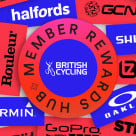Preparing Your Bike - Bike Checks & Essential Maintenance
This advice and more is also available in British Cycling's "Wise Words" section of this website. Also worth a look in particular is the Absolute Beginners section.
 The Essential Roadside Repair Kit
The Essential Roadside Repair Kit
Here are things that you should never go on a long ride without. And when I say 'long ride' I mean any distance that you'd really rather not walk.
- Spare Tube
- Puncture Kit
- Allen Key set
- Chain breaker
- Tyre Levers
- Zip ties
- Pump
- Small change/mobile phone
- Taxi number
Quick Bike Check
Even if you're not a highly trained mechanic, you can quickly check over you and your family's bikes to make sure they're safe to ride. And here's how.
- Apply both brakes firmly, they should stop the bike after moving through no more than half of the lever travel
- Check that the brake blocks line up correctly with the rim (not the tyre!) and are not excessively worn - if in doubt, replace them.
- Make sure that your brake cables are tightly secured at the brakes and are not frayed - if in doubt, have them replaced at a bike shop.
- While you're on the brakes, rock the bike back and forth. If you can feel play or looseness, either your brakes or headset are loose. If you're not sure what to do, take the bike to a shop.
- Check that your handlebars are secure in the stem and the stem is secure in the front forks. Try to rotate the bars forward and backward and side to side. If there is any movement, tighten the bolts securing the handlebars or stem.
- Check that both wheels are firmly attached to the frame by rocking them from side to side. Play in the wheels can mean one of two things; either the wheel is loose or there is wear in the bearing. The former is more serious but both will require attention. Make sure that the wheel nuts or quick release is securely fastened - if the play persists, take it to a bike shop who will adjust your wheel bearings.
- On smooth, flat ground, away from traffic, check that you can change easily from one gear to another and that the chain doesn't skip off the cogs. It can be really dangerous if you unship your chain in traffic. If the chain slips, get the bike to a shop to be checked over.
- If you're going out at night or in poor visibility, make sure that your lights are correctly attached and working properly.
If you're unsure or wary about any aspect of your bike, take it to a quality bike shop for a service. Or if you're the self sufficient type (and most cyclists are) get yourself onto a bike maintenance course. You'll learn valuable skills and be able to pass them on to friends and family.

- Whatever type of tyres you run, keep them pumped up within their recommended range of pressures. They'll roll better, last longer and resist punctures better.
- Check your tires regularly for embedded thorns, glass and other debris. They are an puncture just waiting to happen.
- Cuts in your tyre tread can be repaired with superglue. Deflate the tire, clean the area, let it dry and then drizzle a small amount of superglue into the cut, press it together for a minute and voila, your tyre is repaired.
- Never ride on a flat tyre, it'll damage your tyres, tubes and rims.
- If weight is not a big issue, try Slime tubes, they work really well and seal most of the small cuts that'll normally stop you in your tracks. Top tip though - carry a normal tube as a backup - if you get a big cut that the Slime fails to seal, patching a green slime covered tube is pretty difficult at the roadside.
Punctures
There are two ways to fix a flat. You can either swap the inner tube, or you can fix the hole in the existing tube. Long term, you need to learn both, because sooner or later you'll get two flats in one ride and have to make good one of your punctured tubes to get home. However, it's infinitely preferable to save patching tubes for when you get home to the warm and dry. Because its always raining when you get a puncture. It's the law.

- Remove the wheel - you may need to back off the brakes on some bikes - if it's the rear wheel on a derailleur equipped bike, shift the gears onto the smallest cog
- Take your tyre levers and place one under the bead of the tyre. Lever it out from under the rim and tuck the hooked end of the lever behind a spoke.
- Take the next lever and do the same a few centimetres away from the first.
- Take the third and repeat - with any luck, the tyre will have broken free of the rim by now.
- By hand, free the tyre from the rim on one side, all the way around.
- Find the valve hole and push the valve through and remove the punctured tube.
- Check your tyre thoroughly inside and out for the source of the puncture. It may still be in your tyre. Watch you don't cut yourself on the embedded glass as you run your fingers around the inside of the tyre. Remove any offending articles
- Get your new tube and put a little air in it until it is slightly round.
- Locate the valve in the valve hole and then carefully feed the rest of the tube back into the tyre.
- Starting at the valve hole and using your fingers only, begin to seat the tyre back on the rim. You may need to develop some extra finger strength to do this.
- Work your way around the tyre and seat it on the rim all the way round. They best way to do this is to do it two-handed with the tyre resting on the ground or against your body - work in a symmetrical way until your hands meet again at the bottom.
- Make sure that the tyre is really snug all the way round and add a little more air.
- Check again that the tyre is still full seated ? if not, deflate, reseat and try again.
- Pump the tyre up to its recommended pressure, or more realistically, as hard as you can get with with a mini pump
- When you get home, check your tyre pressure and inflate to correct pressure using a floor (track) pump.
How to repair a tube
Always try your best to avoid doing this on the road, you'll invariably be in a rush and liable to do a less than satisfactory job.
- Put a little air in the tyre and find where the air is escaping. Beware of over inflating skinny road bike tubes - they go pop with alarming ease!
- Mark the site of the puncture with the little crayon provided (no it's not there for impromptu roadside doodles!)
- Grab the sandpaper/little metal file/ or rough area on the puncture kit box and roughen the area around the puncture site.
- Decide which size patch to use - use the smallest one that you can get away with.
- Get the glue and spread a thin coating over the puncture approximating the size of the patch, plus a little more.
- THE MOST IMPORTANT BIT THAT EVERYONE MISSES - let the glue dry. Really, let it dry. Go and make a cup of tea, put the washing in the drier - ponder the infinite, whatever. Now, peel the backing off the patch, to reveal the shiny black side.
- Stick this firmly and centrally over the puncture and press down hard for a few seconds.
- Rub down the patch all over its area, ensuring that the edges are firmly stuck.
- Gently peel off the backing, paying special attention to ensure the edges don't lift.
- Now get the chalk (again, no it's not for roadside doodling/art lessons) and grate a little over the patched area and gently dust it over with your fingers. This will neutralise the excess glue and stop the tube sticking to the inside of the tyre when you use it next - tyres should be able to move freely against the tube.
- Voila! Job done.
How to avoid punctures in the first place
Avoid punctures at all costs by being realistic about the type of tires you need for your riding. Are you a commuter? Then why are you running ultra light race tyres? Get some tougher touring or city rubber and pump em up hard. Yes they will be slower that race tyres but think tortoise and hare. Think missing your train or arriving at work covered in road slime with dirt under your fingernails.
Avoid patching tubes on the roadside. Take a spare tube and leave fixing tubes for that idle time in front of the fire.

Despite the profusion of chain bath type degreasers, there's a strong argument to not to completely degrease your chain regularly. The main place where a chain needs lube is inside the rollers, not all over the outside. So if you soak your chain in degreaser you'll strip the lube from the inside. Instead, regularly wipe down the outside of the chain with some degreaser on a rag and sparingly apply lube to the rollers, then wipe off all the excess. This way, the lube will get to the rollers and won't attract too much dirt. Every once in a while,if your chain starts to look gunky, you can degrease thoroughly with a chain bath, but make sure you relube thoroughly afterwards and let it soak in.
- If you're a high mileage rider, consider running two chains and swapping them regularly. This way you'll get more mileage from your chainwheels and sprockets.
- If your gears jump in a regular fashion, chances are that you've got stiff link in your chain. This can be caused by a few things - a lack of lube or improper joining. If the chain is lacking lube, give the chain a thorough oiling and manipulate the chain in your hands until it frees up. If it has a stiff link after rejoining, you can often loosen the link by gripping the chain on each side of the stiff link and bending it gently from side to side.
- Chain length is important to proper shifting and chain retention. Determining the right chain length with a new chain is easy. Without wrapping your chain through the derailleur, wrap it around the biggest ring at the front and the biggest sprocket at the back. Now add 3 full links and bingo - correct chain length.
- Another way to check chain length with the chain on the bike is to shift to the biggest ring on the front and the smallest on the back. In this gear, the two jockey wheels in the rear derailleur should be vertically aligned - i.e. the jockey wheel cage should be at ninety degrees to the the ground.
- You can get 'dry' chain lubes that dry out completely and protect the chain, which don't attract dirt. I've used them summer and winter and they work a treat, especially if you don't degrease in between applications - just wipe down, add more lube, wipe off the excess and wait a few minutes before you ride. The chain stays slick and clean and so do your pants!




